Mitigation Potential of Sanitation Infrastructure on Groundwater Contamination by Nitrate in Maputo
Abstract
1. Introduction
2. Materials and Methods
2.1. Material Flow Analysis Model Development
2.2. Scenarios
2.2.1. Current Situation
- Only fecal sludge that is emptied by formal operators is transported to the wastewater treatment plant,
- Fecal sludge is homogeneously produced throughout the city, and
- The fraction of nitrogen that infiltrates the ground and reaches groundwater sources is the same, irrespective of the source.
2.2.2. Development Scenarios
3. Results
3.1. Fecal Sludge and Wastewater Flows
3.2. Nitrogen Flows
3.2.1. Mass Flows
3.2.2. Sensitivity Analysis and Parameter Knowledge Ranking
4. Discussion
5. Conclusions
Acknowledgments
Author Contributions
Conflicts of Interest
References
- Wakida, F.T.; Lerner, D.N. Non-agricultural sources of groundwater nitrate: A review and case study. Water Res. 2005, 39, 3–16. [Google Scholar] [CrossRef] [PubMed]
- World Health Organization (WHO). Guidelines for Drinking-Water Quality—First Addendum to Third Edition—Volume 1—Recomendations; WHO: Geneva, Switzerland, 2006. [Google Scholar]
- Sajil Kumar, P.J.; Jegathambal, P.; James, E.J. Chemometric evaluation of nitrate contamination in the groundwater of a hard rock area in Dharapuram, South India. Appl. Water Sci. 2014, 4, 397–405. [Google Scholar] [CrossRef]
- Bernard, P.-Y.; Benoît, M.; Roger-Estrade, J.; Plantureux, S. Using biophysical models to manage nitrogen pollution from agricultural sources: Utopic or realistic approach for non-scientist users? Case study of a drinking water catchment area in Lorraine, France. J. Environ. Manag. 2016, 183, 260–274. [Google Scholar] [CrossRef] [PubMed]
- Malki, M.; Bouchaou, L.; Hirich, A.; Ait Brahim, Y.; Choukr-Allah, R. Impact of agricultural practices on groundwater quality in intensive irrigated area of Chtouka-Massa, Morocco. Sci. Total Environ. 2017, 574, 760–770. [Google Scholar] [CrossRef] [PubMed]
- Slabe-Erker, R.; Bartolj, T.; Ogorevc, M.; Kavaš, D.; Koman, K. The impacts of agricultural payments on groundwater quality: Spatial analysis on the case of Slovenia. Ecol. Indic. 2017, 73, 338–344. [Google Scholar] [CrossRef]
- Lockhart, K.M.; King, A.M.; Harter, T. Identifying sources of groundwater nitrate contamination in a large alluvial groundwater basin with highly diversified intensive agricultural production. J. Contam. Hydrol. 2013, 151, 140–154. [Google Scholar] [CrossRef] [PubMed]
- Pastén-Zapata, E.; Ledesma-Ruiz, R.; Harter, T.; Ramírez, A.I.; Mahlknecht, J. Assessment of sources and fate of nitrate in shallow groundwater of an agricultural area by using a multi-tracer approach. Sci. Total Environ. 2014, 470–471, 855–864. [Google Scholar] [CrossRef]
- Stuart, M.E.; Lapworth, D.J. Macronutrient status of UK groundwater: Nitrogen, phosphorus and organic carbon. Sci. Total Environ. 2015, 572, 1543–1560. [Google Scholar] [CrossRef] [PubMed]
- Ouedraogo, I.; Defourny, P.; Vanclooster, M. Mapping the groundwater vulnerability for pollution at the pan African scale. Sci. Total Environ. 2016, 544, 939–953. [Google Scholar] [CrossRef] [PubMed]
- Cronin, A.A.; Pedley, S.; Hoadley, A.W.; Kouonto Komou, F.; Haldin, L.; Gibson, J.; Breslin, N. Urbanisation effects on groundwater chemical quality: Findings focusing on the nitrate problem from 2 African cities reliant on on-site sanitation. J. Water Health 2007, 5, 441–454. [Google Scholar] [CrossRef] [PubMed]
- Kringel, R.; Rechenburg, A.; Kuitcha, D.; Fouépé, A.; Bellenberg, S.; Kengne, I.M.; Fomo, M.A. Mass balance of nitrogen and potassium in urban groundwater in Central Africa, Yaounde/Cameroon. Sci. Total Environ. 2016, 547, 382–395. [Google Scholar] [CrossRef] [PubMed]
- Nyenje, P.M.; Foppen, J.W.; Kulabako, R.; Muwanga, A.; Uhlenbrook, S. Nutrient pollution in shallow aquifers underlying pit latrines and domestic solid waste dumps in urban slums. J. Environ. Manag. 2013, 122, 15–24. [Google Scholar] [CrossRef] [PubMed]
- Wright, J.A.; Cronin, A.; Okotto-Okotto, J.; Yang, H.; Pedley, S.; Gundry, S.W. A spatial analysis of pit latrine density and groundwater source contamination. Environ. Monit. Assess. 2013, 185, 4261–4272. [Google Scholar] [CrossRef] [PubMed]
- Walraevens, K.; Mjemah, I.C.; Mtoni, Y.; Van Camp, M. Sources of salinity and urban pollution in the Quaternary sand aquifers of Dar es Salaam, Tanzania. J. Afr. Earth Sci. 2015, 102, 149–165. [Google Scholar] [CrossRef]
- Sadler, R.; Maetam, B.; Edokpolo, B.; Connell, D.; Yu, J.; Stewart, D.; Park, M.-J.; Gray, D.; Laksono, B. Health risk assessment for exposure to nitrate in drinking water from village wells in Semarang, Indonesia. Environ. Pollut. 2016, 216, 738–745. [Google Scholar] [CrossRef] [PubMed]
- Nga, D.T.; Thao, T.T.; Van Tu, V.; Phuc, P.D.; Nguyen-Viet, H. Development of nutrient cycle through agricultural activities of a rural area in the North of Vietnam. J. Mater. Cycles Waste Manag. 2016. [Google Scholar] [CrossRef]
- Suthar, S.; Bishnoi, P.; Singh, S.; Mutiyar, P.K.; Nema, A.K.; Patil, N.S. Nitrate contamination in groundwater of some rural areas of Rajasthan, India. J. Hazard. Mater. 2009, 171, 189–199. [Google Scholar] [CrossRef] [PubMed]
- Rajmohan, N.; Amarasinghe, U.A. Groundwater quality issues and management in Ramganga Sub-Basin. Environ. Earth Sci. 2016, 75, 1030. [Google Scholar] [CrossRef]
- Pujari, P.R.; Padmakar, C.; Labhasetwar, P.K.; Mahore, P.; Ganguly, A.K. Assessment of the impact of on-site sanitation systems on groundwater pollution in two diverse geological settings-a case study from India. Environ. Monit. Assess. 2012, 184, 251–263. [Google Scholar] [CrossRef] [PubMed]
- Shivendra, B.T.; Ramaraju, H.K. Impact of Onsite Sanitation System on Groundwater in Different Geological Settings of Peri Urban Areas. Aquat. Procedia 2015, 4, 1162–1172. [Google Scholar] [CrossRef]
- Templeton, M.R.; Hammoud, A.S.; Butler, A.P.; Braun, L.; Foucher, J.-A.; Grossmann, J.; Boukari, M.; Faye, S.; Patrice Jourda, J. Nitrate pollution of groundwater by pit latrines in developing countries. AIMS Environ. Sci. 2015, 2, 302–313. [Google Scholar] [CrossRef]
- Tindall, J.A.; Petrusak, R.L.; Mcmahon, P.B. Nitrate Transport and Transformation Processes in Unsaturated Porous-Media. J. Hydrol. 1995, 169, 51–94. [Google Scholar] [CrossRef]
- Brunner, P.H.; Rechberger, H. Practical Handbook of Material Flow Analysis; CRC Press: Boca Raton, FL, USA, 2003. [Google Scholar]
- Allesch, A.; Brunner, P.H. Material flow analysis as a decision support tool forwaste management: A literature review. J. Ind. Ecol. 2015, 19, 753–764. [Google Scholar] [CrossRef]
- Meinzinger, F.; Kröger, K.; Otterpohl, R. Material flow analysis as a tool for sustainable sanitation planning in developing countries: Case study of Arba Minch, Ethiopia. Water Sci. Technol. 2009, 59, 1911–1920. [Google Scholar] [CrossRef] [PubMed]
- Yiougo, L.; Koanda, H.; Luethi, C.; Wéthé, J. Application of the material flow analysis method for evaluating strategic sanitation plan in Sub-Saharan Africa: The case of Fada N’Gourma-Burkina Faso. Water Sci. Technol. 2011, 63, 2498–2504. [Google Scholar] [CrossRef] [PubMed]
- Buchner, H.; Laner, D.; Rechberger, H.; Fellner, J. Material flow analysis as basis for efficient resource management—The case of aluminium flows in Austria. Metall. Res. Technol. 2014, 111, 351–357. [Google Scholar] [CrossRef]
- Palm, V.; Östlund, C. Lead and zinc flows from technosphere to biosphere in a city region. Sci. Total Environ. 1996, 192, 95–109. [Google Scholar] [CrossRef]
- Baccini, P. Understanding regional metabolism for a sustainable development of urban systems. Environ. Sci. Pollut. Res. 1996, 3, 108–111. [Google Scholar] [CrossRef] [PubMed]
- Roy, M.; Curry, R.; Ellis, G. Spatial allocation of material flow analysis in residential developments: A case study of Kildare County, Ireland. J. Environ. Plan. Manag. 2014, 0568, 1–21. [Google Scholar] [CrossRef]
- Hendriks, C.; Obernosterer, R.; Müller, D.; Kytzia, S.; Baccini, P.; Brunner, P.H. Material Flow Analysis: A tool to support environmental policy decision making. Case-studies on the city of Vienna and the Swiss lowlands. Local Environ. 2000, 5, 311–328. [Google Scholar] [CrossRef]
- Van der Hoek, J.P.; de Fooij, H.; Struker, A. Wastewater as a resource: Strategies to recover resources from Amsterdam’s wastewater. Resour. Conserv. Recycl. 2016, 113, 53–64. [Google Scholar] [CrossRef]
- Buathong, T.; Boontanon, S.K.; Boontanon, N.; Surinkul, N.; Harada, H.; Fujii, S. Nitrogen Flow Analysis in Bangkok City, Thailand: Area Zoning and Questionnaire Investigation Approach. Procedia Environ. Sci. 2013, 17, 586–595. [Google Scholar] [CrossRef]
- Do-Thu, N.; Morel, A.; Nguyen-Viet, H.; Pham-Duc, P.; Nishida, K.; Kootattep, T. Assessing nutrient fluxes in a Vietnamese rural area despite limited and highly uncertain data. Resour. Conserv. Recycl. 2011, 55, 849–856. [Google Scholar] [CrossRef]
- Erni, M.; Bader, H.-P.; Drechsel, P.; Scheidegger, R.; Zurbrügg, C.; Kipfer, R. Urban water and nutrient flows in Kumasi, Ghana. Urban Water J. 2011, 8, 135–153. [Google Scholar] [CrossRef]
- Montangero, A.; Le, C.N.; Nguyen, V.A.; Vu, D.T.; Pham, T.N.; Belevi, H. Optimising water and phosphorus management in the urban environmental sanitation system of Hanoi, Vietnam. Sci. Total Environ. 2007, 384, 55–66. [Google Scholar] [CrossRef] [PubMed]
- Woltersdorf, L.; Scheidegger, R.; Liehr, S.; Döll, P. Municipal water reuse for urban agriculture in Namibia: Modeling nutrient and salt flows as impacted by sanitation user behavior. J. Environ. Manag. 2016, 169, 272–284. [Google Scholar] [CrossRef] [PubMed]
- Firmansyah, I.; Spiller, M.; de Ruijter, F.J.; Carsjens, G.J.; Zeeman, G. Assessment of nitrogen and phosphorus flows in agricultural and urban systems in a small island under limited data availability. Sci. Total Environ. 2016, 574, 1521–1532. [Google Scholar] [CrossRef] [PubMed]
- The World Bank World Bank Supports Mozambique in Harnessing the Transformative Potential of Its Growth through Smart Reforms. Available online: http://www.worldbank.org/en/news/press-release/2015/12/22/world-bank-supports-mozambique-in-harnessing-the-transformative-potential-of-its-growth-through-smart-reforms (accessed on 15 March 2016).
- United Nations Development Programme (UNDP). Human Development Report 2015—Work for Human Development; UNDP: New York, NY, USA, 2015. [Google Scholar]
- Jenkins, P. City profile: Maputo. Cities 2000, 17, 207–218. [Google Scholar] [CrossRef]
- Kemp, L.; Fairhurst, L.; Rowswell, P.; Quayle, T. Sub-Saharan African Cities: A Five-City Network to Pioneer Climate Adaptation through Participatory Research & Local Action—Maputo Baseline Study. Available online: http://resilientafrica.org/Resources/Final%20Resources/ICLEI%20Africa_5%20City%20Adaptation%20Network_Maputo%20Downscaled%20Climate%20Report.pdf (accessed on 15 March 2018).
- UN-HABITAT. Global Atlas of Excreta, Wastewater Sludge, and Biosolids Management: Moving forward the Sustainable and Welcome Uses of a Global Resource; LeBlanc, R.J., Matthews, P., Richard, R.P., Eds.; UN-HABITAT: Nairobi, Kenya, 2008. [Google Scholar]
- Instituto Nacional de Estadística (INE). III Recenseamento Geral da População e Habitação em 2007. Indicadores Socio-demográficos Distritais. Maputo Província; INE: Madrid, Spain, 2011. [Google Scholar]
- Rietveld, L.C.; Siri, J.G.; Chakravarty, I.; Arsénio, A.M.; Biswas, R.; Chatterjee, A. Improving health in cities through systems approaches for urban water management. Environ. Health 2016, 15 (Suppl. 1), S31. [Google Scholar] [CrossRef] [PubMed]
- Water and Sanitation Programme (WSP). Caracterização do Saneamento em Maputo; WSP: Maputo, Mozambique, 2014. (In Portuguese) [Google Scholar]
- Bäuerl, M.; Muximpua, O.; Arsénio, A.M.; Zimba, E. Attitudes and practises with regard to emptying of onsite systems in Maputo, Mozambique. In Proceedings of the 38th WEDC International Conference, Loughborough, UK, 27–31 July 2015; Volume 1, pp. 1–5. [Google Scholar]
- Hydroconseil-WEConsult. Sustainable Management of the Groundwater Resources in the Maputo Metropolitan Areas—Main Report; Hydroconseil-WEConsult: Maputo, Mozambique, 2011. [Google Scholar]
- Bhatt, J. Comparison of small-scale providers’ and utility performance in urban water supply: The case of Maputo, Mozambique. Water Policy 2014, 16, 102–123. [Google Scholar] [CrossRef]
- Nogueira, G.E.H. Tracing the Hydrochemical Water Types and Salinization Mechanisms in the Great Maputo Area as a Function of Groundwater Recharge, Hydrogeological Properties and Human Activities; IHE: Delft, The Netherlands, 2017. [Google Scholar]
- Vicente, E.M.; Jermy, C.A.; Schreiner, H.D. Urban geology of Maputo, Mocambique. In Proceedings of the 10th IAEG International Congress, Nottingham, UK, 6–10 September 2006. [Google Scholar]
- Matsinhe, N.P.; Juízo, D.; Rietveld, L.C.; Persson, K.M. Water services with independent providers in peri-urban Maputo: Challenges and opportunities for long-term development. Water SA 2008, 34, 411–420. [Google Scholar]
- Muxímpua, O.; Hawkins, P. Building Blocks for Effective Faecal Sludge Management in Per-Urban Areas: The Role of Small-Scale Service Providers in Maputo. In Proceedings of the 2nd International Feacal Sludge Management Conference, Durban, South Africa, 29–31 October 2012. [Google Scholar]
- Montangero, A. Material Flow Analysis—A Tool to Assess Material Flows for Environmental Sanitation Planning in Developing Countries; Eawag: Dübendorf, Switzerland, 2007. [Google Scholar]
- Woltersdorf, L.; Liehr, S.; Scheidegger, R.; Döll, P. Small-scale water reuse for urban agriculture in Namibia: Modeling water flows and productivity. Urban Water J. 2015, 12, 414–429. [Google Scholar] [CrossRef]
- Montangero, A.; Belevi, H. An approach to optimise nutrient management in environmental sanitation systems despite limited data. J. Environ. Manag. 2008, 88, 1538–1551. [Google Scholar] [CrossRef] [PubMed]
- INAM. Instituto Nacional de Metereologia. Available online: http://www.inam.gov.mz (accessed on 9 May 2016).
- Tadross, M.; Johnston, P. Climate Change Projections for Walvis Bay: Adding Value through Downscaling; IDRC: Cape Town, South Africa, 2011. [Google Scholar]
- FAOSTAT Food Balance Sheets for Mozambique. Available online: http://www.fao.org/faostat/en/#data/FBS (accessed on 10 February 2017).
- Food and Agriculture Organization (FAO); World Health Organization (WHO). Codex Alimentarius—Cereals, Pulses, Legumes and Vegetable Proteins, 1st ed.; WHO: Geneva, Switzerland, 2007. [Google Scholar]
- Gustavsson, J.; Cederberg, C.; Sonesson, U.; van Otterdijk, R.; Meybeck, A. Global Food Losses and Food Waste—Extent, Causes and Prevention; FAO: Rome, Italy, 2011. [Google Scholar]
- Tas, A.; Belon, A. A Comprehensive Review of the Municipal Solid Waste Sector in Mozambique—Background Documentation for the Formulation of Nationally Appropriate Mitigation Actions in the Waste Sector in Mozambique; Carbon Africa Limited: Nairobi, Kenya, 2014. [Google Scholar]
- Baucom, I.K.; Ruhl, C.H. CCP Landfill Leachate Generation and Leachate Management. In Proceedings of the 2013 World of Coal Ash (WOCA) Conference, Lexington, Kentuck, 22–25 April 2013. [Google Scholar]
- American Institute of Architecture Students (AIAS). Sanitation and Drainage Master Plan for the Greater Maputo Metropolitan Area; AIAS: Maputo, Mozambique, 2015. [Google Scholar]
- Montangero, A.; Belevi, H. Assessing nutrient flows in septic tanks by eliciting expert judgement: A promising method in the context of developing countries. Water Res. 2007, 41, 1052–1064. [Google Scholar] [CrossRef] [PubMed]
- Muiuane, E. The Quality of Groundwater in and around Maputo City, Mozambique, Universidade Eduardo Mondlane; Universidade Eduardo Mondlane: Maputo, Mozambique, 2007. [Google Scholar]
- Food and Agriculture Organization (FAO). Food Composition Table for Use in Africa; FAO: Rome, Italy, 1968. [Google Scholar]
- Korkalo, L.; Hauta-alus, H.; Mutanen, M. Food Composition Tables for Zambia; Department of Food and Environmental Sciences University of Helsinki: Helsinki, Finland, 2011. [Google Scholar]
- Landau, D.P.; Binder, K. A Guide to Monte Carlo Simulations in Statistical Physics; Cambridge University Press: Cambridge, UK, 2014; ISBN 978-1-107-07402-6. [Google Scholar]
- Boot, N.L.D. The use of transfer stations for faecal sludge management in Accra, Ghana. Waterlines 2008, 27, 71–81. [Google Scholar] [CrossRef]
- Schaffner, M.; Bader, H.P.; Scheidegger, R. Modeling the contribution of point sources and non-point sources to Thachin River water pollution. Sci. Total Environ. 2009, 407, 4902–4915. [Google Scholar] [CrossRef] [PubMed]
- Dodane, P.-H.; Mbéguéré, M.; Sow, O.; Strande, L. Capital and Operating Costs of Full-Scale Faecal Sludge Management and Wastewater Treatment Systems in Dakar, Senegal. Environ. Sci. Technol. 2012, 46, 3705–3711. [Google Scholar] [CrossRef] [PubMed]
- Paterson, C.; Mara, D.; Curtis, T. Pro-poor sanitation technologies. Geoforum 2007, 38, 901–907. [Google Scholar] [CrossRef]
- Jenkins, M.; Cumming, O.; Cairncross, S. Pit Latrine Emptying Behavior and Demand for Sanitation Services in Dar Es Salaam, Tanzania. Int. J. Environ. Res. Public Health 2015, 12, 2588–2611. [Google Scholar] [CrossRef] [PubMed]
- McConville, J.R. Unpacking Sanitation Planning—Comparing Theory and Practice; Chalmers University of Technology: Gothenburg, Sweden, 2010. [Google Scholar]
- Neitsch, S.; Arnold, J.; Kiniry, J.; Williams, J. Soil and Water Assessment Tool, Theoretical Documentation, Version 2009; Technical Report No. 406; Texas Water Resources Institute: College Station, TX, USA, 2011. [Google Scholar]
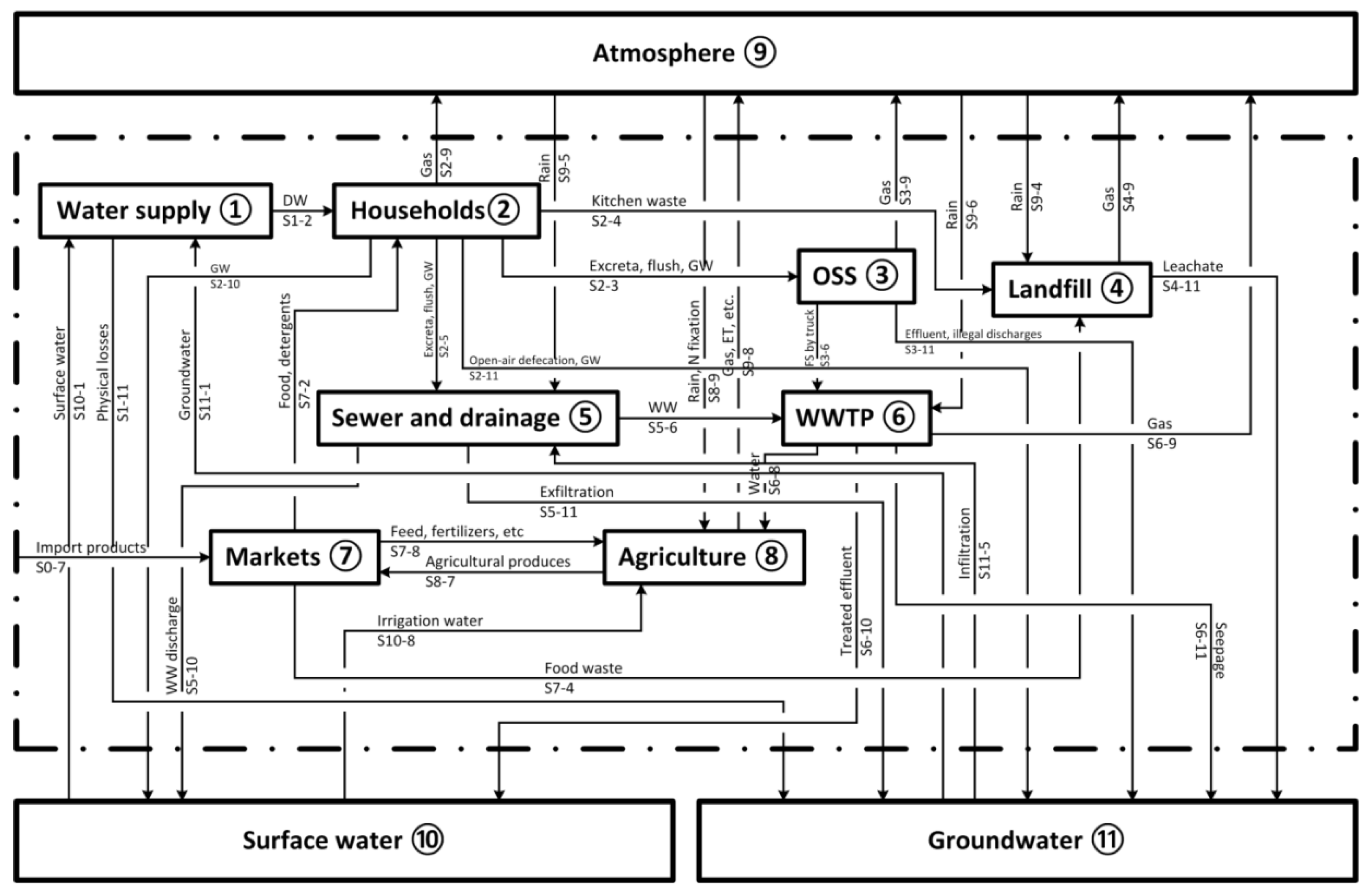
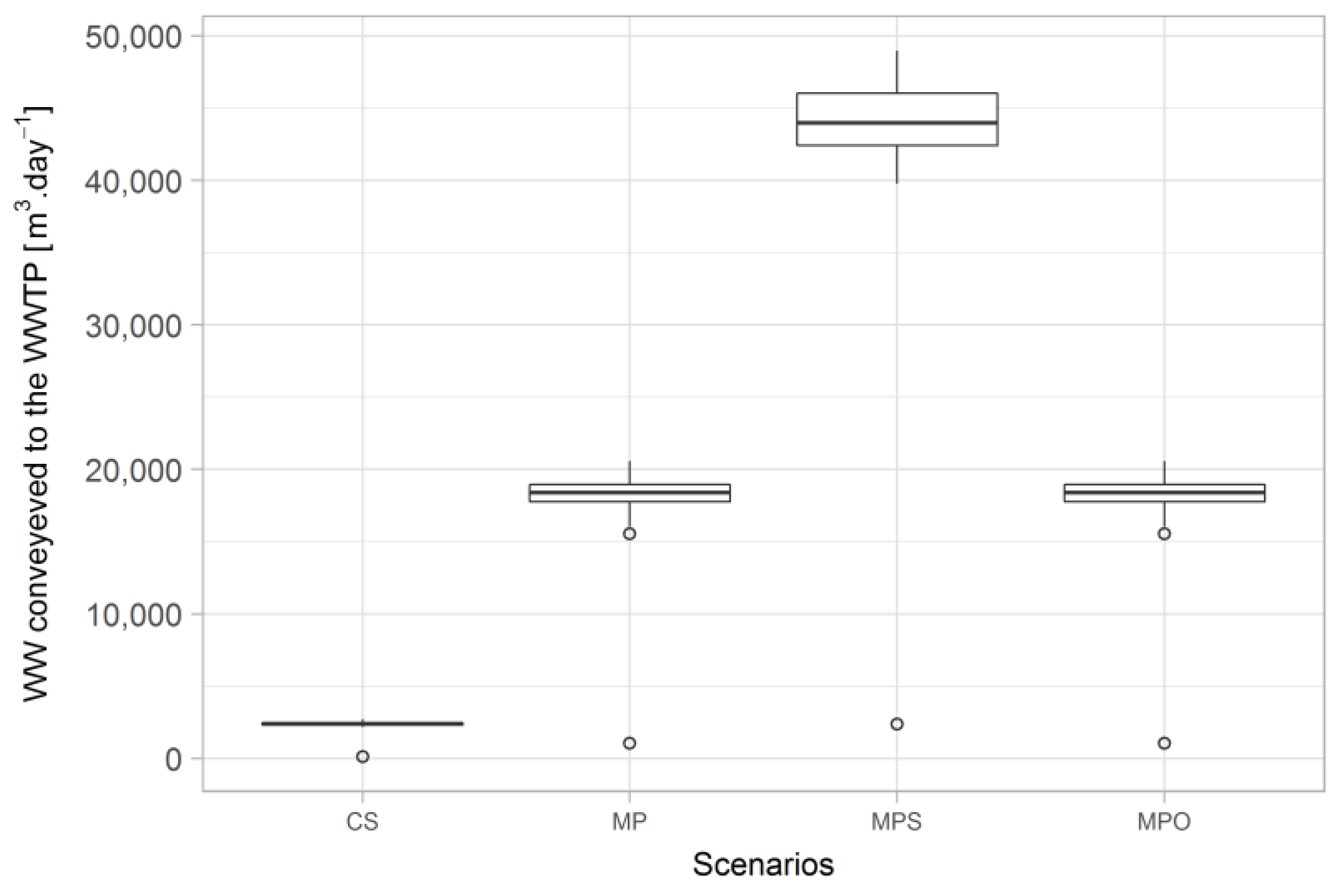
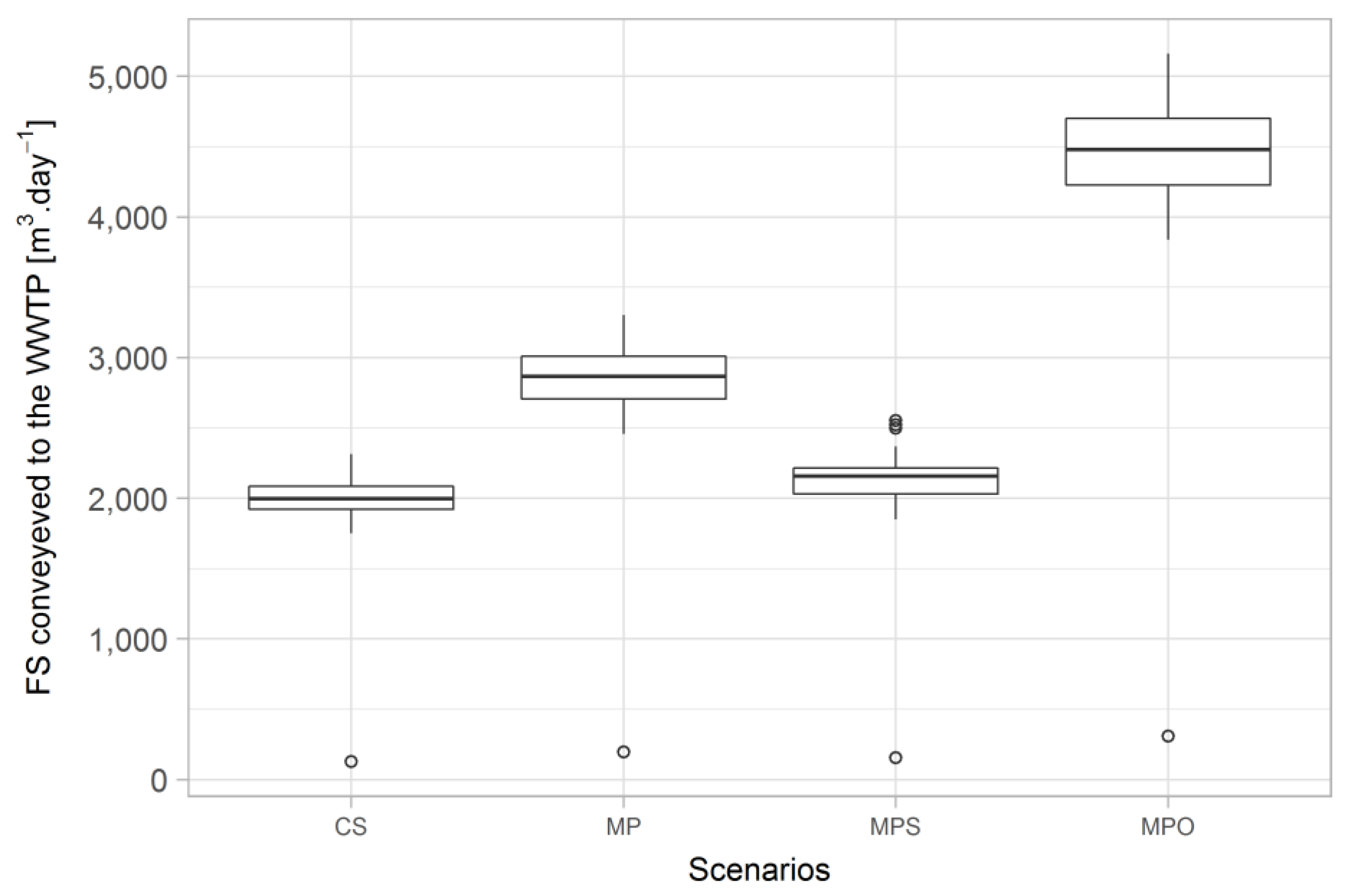
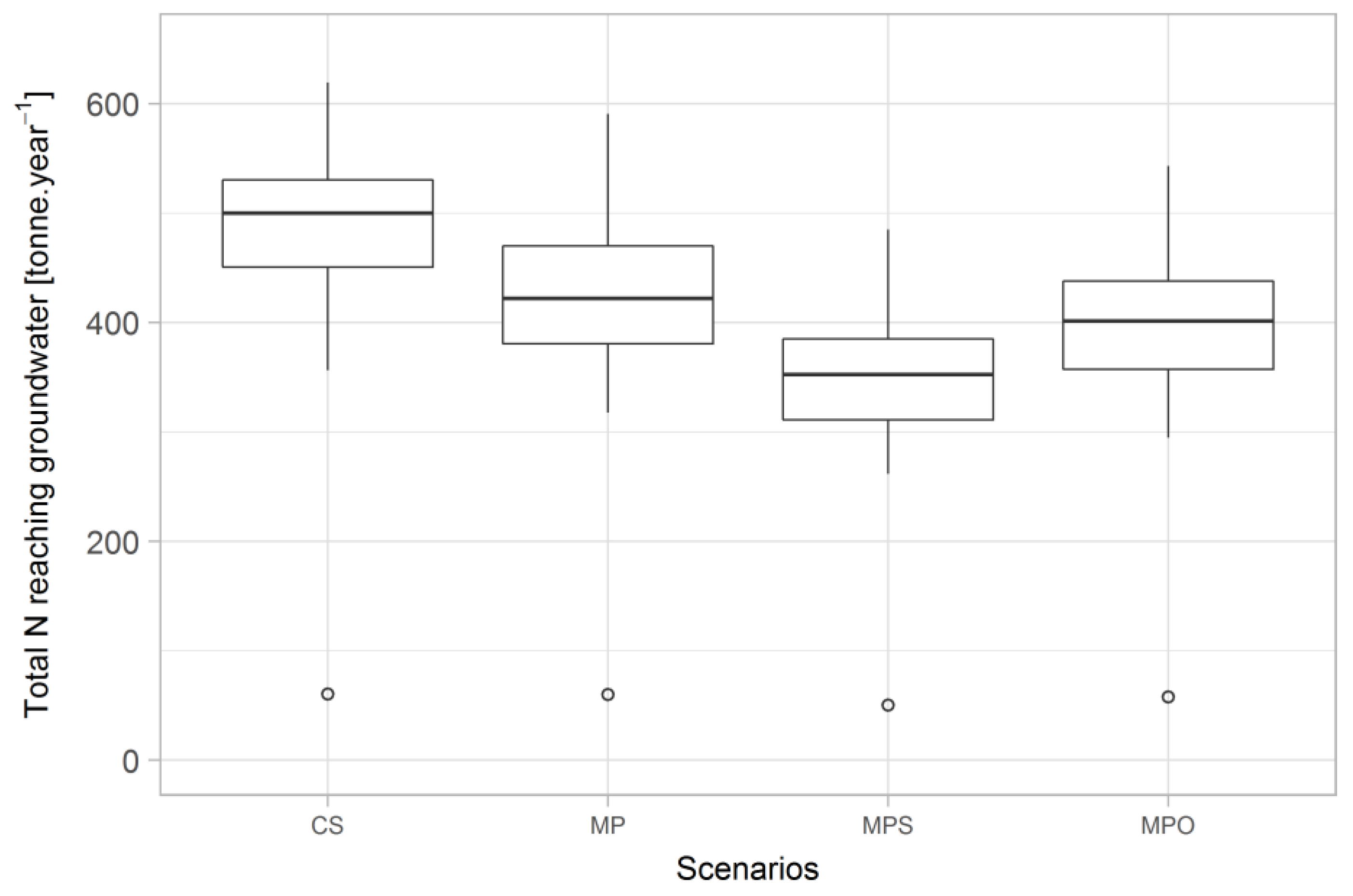
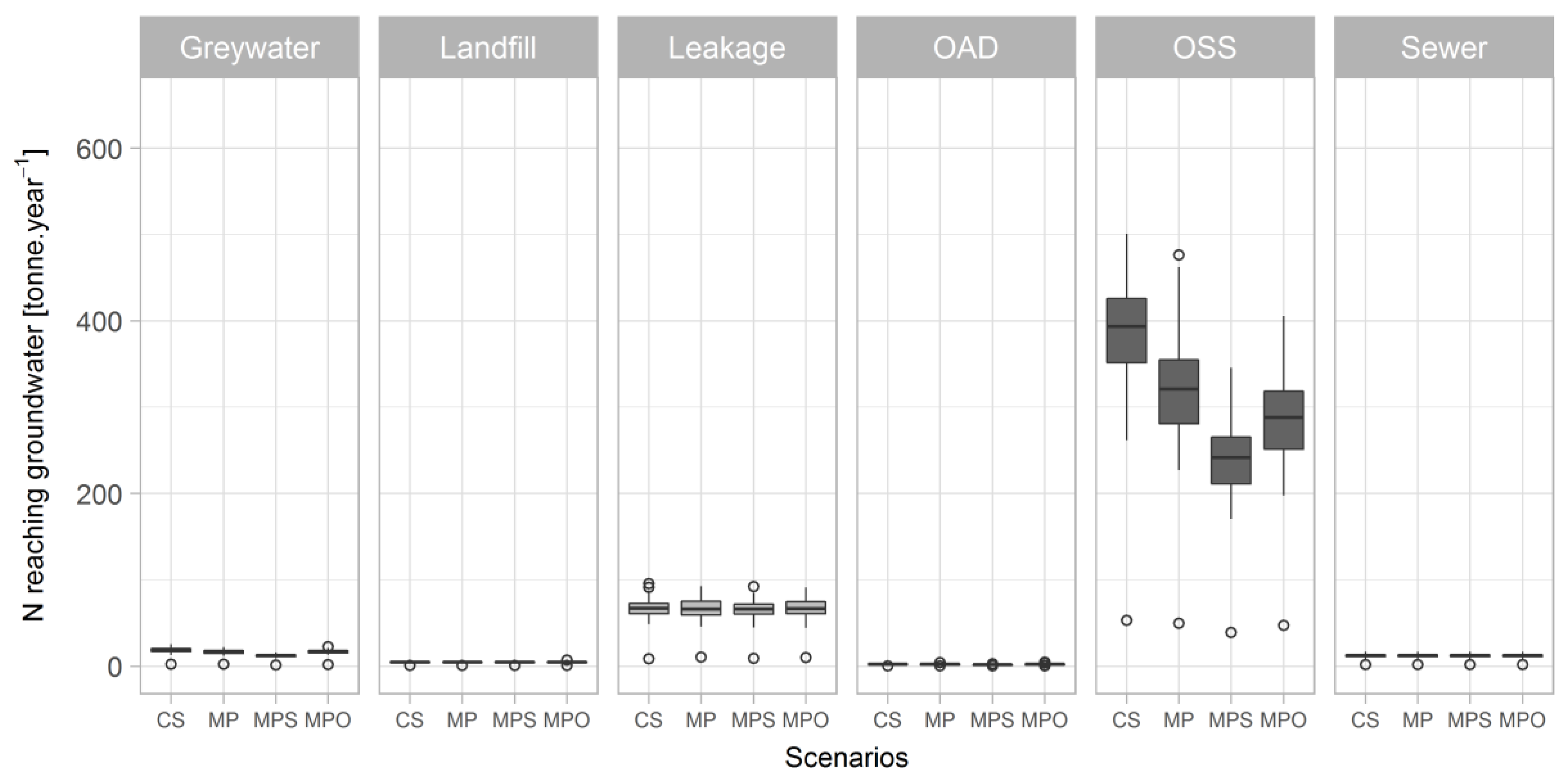
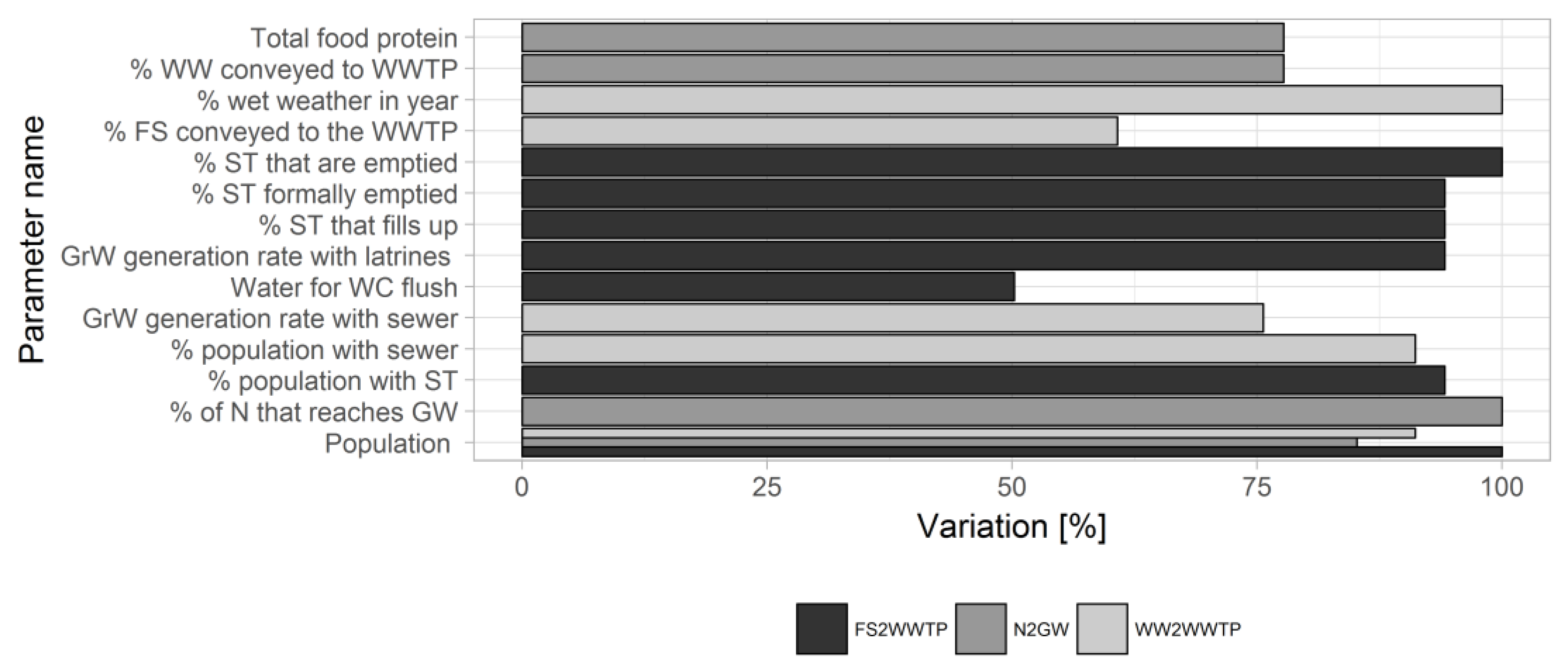
| Units | Probability Distribution | Mean | Standard Deviation | Reference(s) | |
|---|---|---|---|---|---|
| Population | Cap | Truncated normal | 1,980,263 | 99013 | [45] |
| Precipitation | mm year−1 | Normal | 811 | 41 | [58] |
| Evapotranspiration | mm year−1 | Normal | 1300 | 65 | [59] |
| Area of Maputo | ha | Normal | 108,500 | 0 | Local experts |
| % N that reaches GW | [-] | Uniform | 8 | 12 | [13] |
| % the population supplied by SSIPs | [-] | Truncated normal | 37 | 2 | Local experts |
| % the population supplied by ARM from SW | [-] | Truncated normal | 99 | 5 | Local experts |
| Total water supplied by ARM | m3 year−1 | Normal | 39,773,150 | 1,988,658 | Local experts |
| Total water supplied SSIPs | m3 year−1 | Normal | 23,691,472 | 1,184,574 | Local experts |
| % leakage by ARM from GW | [-] | Truncated normal | 28 | 1 | Local experts |
| % leakage by ARM from SW | [-] | Truncated normal | 41 | 2 | Local experts |
| % leakage by SSIPs from GW | [-] | Truncated normal | 20 | 1 | Local experts |
| % water supplied by SSIPs to households | [-] | Truncated normal | 95 | 5 | Local experts |
| % water supplied by ARM to households | [-] | Truncated normal | 71 | 4 | Local experts |
| Pulses consumption | Kg cap−1 year−1 | Normal | 14 | 1 | [60] |
| Fish, seafood consumption | Kg cap−1 year−1 | Normal | 8 | 0.81 | [61] |
| Fruits consumption | Kg cap−1 year−1 | Normal | 26 | 3 | [60] |
| % population with ST | [-] | Truncated normal | 39 | 0.39 | [47] |
| % population with pour-flush latrines | [-] | Truncated normal | 13 | 0.13 | [47] |
| % population with improved latrine | [-] | Truncated normal | 32 | 0.32 | [47] |
| % population with traditional latrine | [-] | Truncated normal | 10 | 0.1 | [47] |
| % population with sewer | [-] | Truncated normal | 5 | 0.06 | [47] |
| GrW generation rate with ST | L.cap−1 day−1 | Normal | 50 | 3 | Local experts |
| GrW generation rate with pour-flush latrine | L.cap−1 day−1 | Normal | 35 | 2 | Local experts |
| GrW generation rate with sewer | L.cap−1 day−1 | Normal | 50 | 3 | Local experts |
| Excreta generation rate | Kg cap−1 day−1 | Normal | 0.25 | 0.03 | [57] |
| Water for WC flush | L.cap−1 day−1 | Normal | 10 | 0.5 | Local experts |
| Water for pour-flush | L.cap−1 day−1 | Normal | 10 | 1 | Local experts |
| Kitchen waste production at household | Kg cap−1 year−1 | Normal | 8 | 0.8 | [62] |
| % kitchen waste that is collected and transported to landfill | [-] | Uniform | 74 | 100 | [63] |
| % water in kitchen waste | [-] | Uniform | 37 | 63 | Authors’ assumption |
| % of water in detergent | [-] | Uniform | 70 | 100 | Authors’ assumption |
| GrW generation rate with latrines | L.cap−1 year−1 | Uniform | 26 | 1 | Authors’ assumption |
| % GrW to OSS (with ST) | [-] | Truncated normal | 17 | 0.85 | [47,48] |
| % GrW to OSS (with latrines) | [-] | Truncated normal | 17 | 0.85 | [47,48] |
| % ST that fills up | [-] | Truncated normal | 41 | 2 | [47,48] |
| % pour-flush latrine that fill up | [-] | Truncated normal | 15 | 0.75 | [47,48] |
| % improved latrine that fill up | [-] | Truncated normal | 25 | 1 | [47,48] |
| % traditional latrine that fill up | [-] | Truncated normal | 13 | 0.65 | [47,48] |
| % ST formally emptied | [-] | Truncated normal | 56 | 3 | [47,48] |
| % pour-flush latrines formally emptied | [-] | Truncated normal | 37 | 2 | [47,48] |
| % improved latrines formally emptied | [-] | Truncated normal | 14 | 0.7 | [47,48] |
| % traditional latrines formally emptied | [-] | Truncated normal | 6 | 0.3 | [47,48] |
| % ST that are emptied | [-] | Truncated normal | 57 | 3 | [47,48] |
| % pour-flush latrines that are emptied | [-] | Truncated normal | 51 | 3 | [47,48] |
| % improved latrines that are emptied | [-] | Truncated normal | 33 | 2 | [47,48] |
| % traditional latrines that are emptied | [-] | Truncated normal | 20 | 1 | [47,48] |
| % FS conveyed to the WWTP | [-] | Truncated normal | 100 | 5 | [47,48] |
| Area of landfill | ha | Truncated normal | 17 | 0.85 | [63] |
| % rain becoming leachate | [-] | Truncated normal | 30 | 3 | [64] |
| % impervious area in the city | [-] | Truncated normal | 7 | 0.35 | [65] |
| % dry weather in year | [-] | Truncated normal | 40 | 2 | [58] |
| % GW infiltration to sewer network | [-] | Truncated normal | 20 | 2 | [66] |
| % exfiltration from sewer network | [-] | Truncated normal | 10 | 1 | [66] |
| % WW conveyed to WWTP | [-] | Truncated normal | 30 | 2 | Local experts |
| % area occupied by sewer network | [-] | Truncated normal | 0.69 | 0.03 | [65] |
| Area of the lagoon system | Ha | Normal | 4 | 0.19 | Local experts |
| % losses due to seepage in the lagoon system | [-] | Truncated normal | 20 | 2 | [66] |
| N concentration in GW abstracted by SSIPs | mg L−1 | Lognormal | 92 | 7 | [50,67] |
| N concentration in GW abstracted by ARM | mg L−1 | Lognormal | 55 | 7 | [50,67] |
| N concentration in surface water abstracted by ARM | mg L−1 | Lognormal | 0 | 0 | Local experts |
| N concentration in pulses | g kg−1 | Lognormal | 11 | 1 | [66,68,69] |
| N concentration in fish, seafood | g kg−1 | Lognormal | 30 | 3 | [66,68,69] |
| N concentration in fruits | g kg−1 | Lognormal | 1 | 0.11 | [66,68,69] |
| N concentration in leachate from landfill | mg L−1 | Lognormal | 1100 | 110 | [36,66] |
| N removal efficiency (%) | [-] | Truncated normal | 10 | 5 | Local experts |
| N removed that turns into biomass (%) | [-] | Uniform | 59 | 100 | Authors’ assumption |
| % Sewer 1 | % OSS 2 | Type of OSS | OSS That Fill-Up 3 | OSS Emptied 4 | OSS Formally Emptied 5 | |
|---|---|---|---|---|---|---|
| Current situation | 5 | 946 | ST | 41 | 23 | 13 |
| PFL | 15 | 8 | 3 | |||
| IL | 25 | 8 | 1 | |||
| TL | 13 | 3 | 0 | |||
| Scenario MP | 14 | 86 | ST | 41 | 29 | 20 |
| PFL | 15 | 10 | 4 | |||
| IL | 25 | 10 | 2 | |||
| TL | 13 | 3 | 0 | |||
| Scenario MPS | 37 | 63 | ST | 41 | 29 | 20 |
| PFL | 15 | 10 | 4 | |||
| IL | 25 | 10 | 2 | |||
| TL | 13 | 3 | 0 | |||
| Scenario MPO | 14 | 86 | ST | 51 | 37 | 26 |
| PFL | 19 | 12 | 6 | |||
| IL | 31 | 13 | 2 | |||
| TL | 16 | 4 | 0 |
| FS Conveyed to TP (m3 Day−1) | WW Conveyed to TP (m3 Day−1) | N Reaching GW (Tonne Year−1) | |
|---|---|---|---|
| Current situation (CS) | 1977 | 2353 | 492 |
| Scenario MP | 2891 | 18214 | 424 |
| Scenario MP/CS | 1.46 | 7.74 | 0.86 |
| Scenario MPS | 2109 | 43302 | 350 |
| Scenario MPS/CS | 1.07 | 18.4 | 0.71 |
| Scenario MPO | 4502 | 17983 | 397 |
| Scenario MPO/CS | 2.28 | 7.64 | 0.81 |
| Cumulative Ranking (%) | |
|---|---|
| Parameter | Fecal Sludge Transported to WWTP |
| Population | 18.8 |
| % fecal sludge conveyed to WWTP | 37.5 |
| % of septic tanks that fill up | 54.2 |
| % of septic tanks that are emptied | 70.8 |
| % of septic tanks that formally emptied | 87.4 |
| Water used for flush | 92.2 |
| Greywater generation rate for population with septic tanks | 95.6 |
| % greywater into OSS for population with septic tanks | 99 |
| Wastewater conveyed to WWTP | |
| % of wastewater conveyed to WWTP | 33.3 |
| Population | 61 |
| Greywater generation rate for population with sewer | 80 |
| % wet weather in the year | 92.3 |
| % dry weather in the year | 95.4 |
| % of groundwater infiltration into sewer | 97.2 |
| % of population with sewer | 98.3 |
| Water used for flush | 99.1 |
| Nitrogen reaching groundwater | |
| % of nitrogen that reaches groundwater | 40.9 |
| % of nitrogen in total food protein | 65.6 |
| Total food protein | 90.4 |
| Population | 97.8 |
| % users supplied by ARM from surface water sources | 98.8 |
| Concentration of nitrogen in GW abstracted by SSIPs | 99.3 |
© 2018 by the authors. Licensee MDPI, Basel, Switzerland. This article is an open access article distributed under the terms and conditions of the Creative Commons Attribution (CC BY) license (http://creativecommons.org/licenses/by/4.0/).
Share and Cite
Marques Arsénio, A.; Câmara Salim, I.; Hu, M.; Pedro Matsinhe, N.; Scheidegger, R.; Rietveld, L. Mitigation Potential of Sanitation Infrastructure on Groundwater Contamination by Nitrate in Maputo. Sustainability 2018, 10, 858. https://doi.org/10.3390/su10030858
Marques Arsénio A, Câmara Salim I, Hu M, Pedro Matsinhe N, Scheidegger R, Rietveld L. Mitigation Potential of Sanitation Infrastructure on Groundwater Contamination by Nitrate in Maputo. Sustainability. 2018; 10(3):858. https://doi.org/10.3390/su10030858
Chicago/Turabian StyleMarques Arsénio, André, Iana Câmara Salim, Mingming Hu, Nelson Pedro Matsinhe, Ruth Scheidegger, and Luuk Rietveld. 2018. "Mitigation Potential of Sanitation Infrastructure on Groundwater Contamination by Nitrate in Maputo" Sustainability 10, no. 3: 858. https://doi.org/10.3390/su10030858
APA StyleMarques Arsénio, A., Câmara Salim, I., Hu, M., Pedro Matsinhe, N., Scheidegger, R., & Rietveld, L. (2018). Mitigation Potential of Sanitation Infrastructure on Groundwater Contamination by Nitrate in Maputo. Sustainability, 10(3), 858. https://doi.org/10.3390/su10030858





